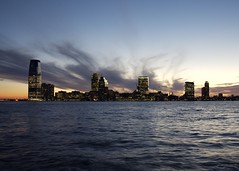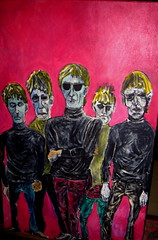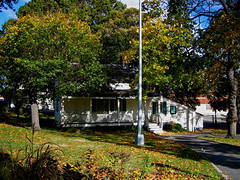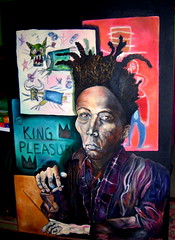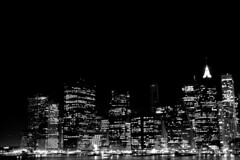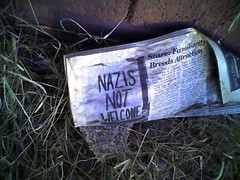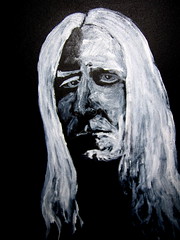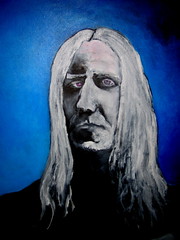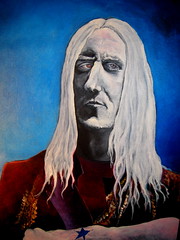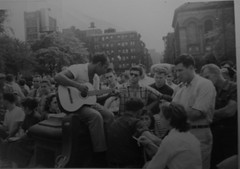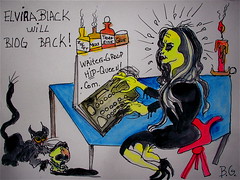Is New York "over?" (Part 2)
Part 1 can be found here.
It often seems to me that the typical New Yorker is never satisfied. No matter how well off they have it, and despite living in what is (to me at least) the greatest city in the world, their complaints are legion.
One of the ways this perpetual dissatisfaction manifests itself is in the state of the neighborhoods residents live in or once lived in. The long-ago metamorphosis of Soho is one prime example. The typical scenario goes something like this:
Young urbanite finds that s/he is priced out of a "desirable" area of Manhattan--or later, even Manhattan itself.
A few brave souls, often artists, decide to explore "uncharted territory." Many decades ago, artists began moving into formerly industrial areas such as SoHo. The area was dark and unwelcoming, with virtually no residential amenities.
After the artists had given it their stamp of approval, others became drawn to the now-hip ambiance of the area. Soho became a mecca of the new arts scene, and restaurants and bars sprung up to accomodate the residents and myriad tourists who came to visit what had become a charming enclave.
Soho's main drag, West Broadway, soon became clogged with retail outlets. My friend D used to say everything was a "gallery"--a clothing gallery, a shoe gallery, a jewelry gallery.
Eventually the area became too expensive for all but the most successful artists, and the more monied non-artists who could afford to bask in their reflected glory. The main art scene and the biggest storefront galleries such as Mary Boone moved from Soho to Chelsea, and other struggling artists looked elsewhere for sufficient space and light to live and work in.
BG, who first came to the city in the summer of "69, often reminisces about how accessible and affordable Manhattan used to be. After returning from his periodic "sabbaticals" at his brother's or parent's places in Louisiana or Wisconsin, he could get off the bus and within an hour or so be set up in a cheap hotel. The per day rate at the Bowery flophouse BG used to frequent when he was too poor to get an apartment is now too steep for him to ever return to. The place has been renovated and harbors, in part, tourists who are looking for cheap accomodations, since a typical Manhattan hotel can run into hundreds a day.
So as Manhattan became out of bounds for artists and the hipsters who followed them, Brooklyn started to become the next big thing. Park Slope, which as I recall used to be rather dangerous, is now chiefly home to yuppie families with young children.
As I mentioned in Part 1, Williamsburg, Brooklyn--once an enclave for the ethnic poor and Orthodox Jews--became a true hippster enclave within a few years' time. Artists began to discover it, and soon young people looking for cheap rents followed. At first, the new residents had to endure the same lack of amenities and crime as the old-timers in the area. But when things started to take off, businesses sprung up to accomodate the culture and lifestyle of the mostly young white new residents. Bars, restaurants, and other necessities of bourgeois New York life began to emerge rapidly.
As neighborhood rents inevitably started to rise, would-be hipsters ventured further into the depths of Williamsburg, starting the whole cycle again. The irony was that those who came there to experience the grittiness of a semi-gentrified area often started to complain that the rapid commercial growth of the area had leeched all the original "character" from it. Though these folks' presence was the primary reason for this change, they complained bitterly that the Williamsburb scene was officially "over."
A recent NY Times piece called The Duel Over Cool illustrates the insecurity of nouveau outer-borough residents. Deep in the heart and soul of most New Yorkers is an enduring envy of Manhattan, and so they must always compensate by declaring their neighborhood to be as good, or better than the city's epicenter. This piece described the rivalry between residents of Long Island City in Queens and Williamsburg over which is the most happening place to live.
When I was in the process of putting my Lower East Side coop up for sale, I eagerly scanned all the real estate websites and blogs I could find. One of the best is Curbed. Updated several times daily, Curbed is the place to learn about real estate and housing trends all over the city. It is here, in the comments section, that one can find the snarky, even downright nasty, grumblings and feuds of the perpetually dissatisfied and/or insecure New Yorker. Here readers guess the asking price of overpriced Manhattan coops while declaring that only an idiot would pay those prices, especially when the housing slowdown hit. Some will praise their neighborhood as the best there is, while others will quickly counter that that area sucks for one reason or another. Things can get downright vicious on the hot comment threads at Curbed.
Recently, Curbed had a short blurb called "The Half-Life of a Trendy Neighborhood," which linked to an audacious article in New York Magazine entitled "If You Lived Here, You’d Be Cool by Now," which started off like this:
"Hot Neighborhood Entropy
Red Hook? Already over. Lower East Side? It’s hot—no, wait, it’s not. No, wait, it is again! The life span of a trendy neighborhood used to be measured in decades. Now it might not last long enough for you to make the subway ride out there."
The jist of the article was that gentrification had accelerated so rapidly that a neighborhood could go from hellhole to cool to "over" in the blink of an eye. Furthermore, the author claimed that Jersey City, which seemed to be showing signs of rapid gentrification, would become the next hot thing--despite the fact that it wasn't even part of New York City.
This provocative post set off an avalanche of comments at Curbed, with various folks sounding off on what neighborhood was cool and not cool. The comment string is well worth a look, but here are a few typical examples:
"The real estate boom and rags like NYMag have created the impression that you can take any poor non-white neighborhood, sprinkle in a few artists, add a yoga studio and a "brunch place" and blammo - the next cool neighborhood! It used to be (I THINK, anyway) that artists and musicians moved to a neighborhood because it was cheap and they wanted to create their own scene, and it was only later that the cool vultures came. Now people think they can make it all happen at once. But I guess the definition of what's "cool" has changed too - turn your lifestyle into a brand, etc."
"Greenpoint and Astoria aren't on that graph, so that dude doesn't know what he's talking about. I think those two neighborhoods trump the South Bronx (SoBro? fck you) as far as the h*pster thing goes."
"new york magazine is for recent transplants and brief reading at the gyno office. by transplants, i mean nonnative new yorkers (not necessarily from the midwest)."
Even though as a typical New Yorker, I can sometimes be under the delusion that the rest of the country is nothing but an arid "wasteland" of cookie-cutter suburbs, I know that other urban areas around the country have seen the same trend emerge. It's just that as with everything else about New York, the trends seem to emerge earlier and be more spectacular in scope than elsewhere.
As for me, I'm moving from Manhattan to the Bronx--in all it's semi-pre-gentrified glory.
